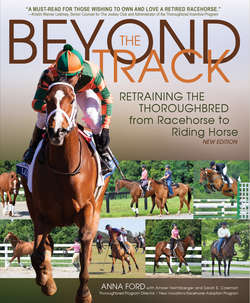Читать книгу Beyond the Track - Anna Morgan Ford - Страница 32
На сайте Литреса книга снята с продажи.
For Sale by Trainer:
Finding a Horse at the Track
ОглавлениеOn any given day, at most racetracks, there are a number of retired horses for sale. Prices can run the gamut—I’ve seen them range from as low as $300 to $5,000. Trainers with horses for sale usually put the word out by contacting dealers or buyers they’ve worked with before; some even list their horses on the Internet (www.equine.com, www.dreamhorse.com, and www.canterusa.org, for example).
Plenty of people find success purchasing a horse directly from a trainer, but the majority of these are accomplished horsemen who may make their living retraining Thoroughbreds for resale—they know how to identify a good riding prospect even when he is racing fit (and without getting on his back). Some have developed good relationships with Thoroughbred trainers and are able to work regularly with them to find what they are looking for.
2.4 A & B Thoroughbreds are often sold by trainers directly from the track. If arranged ahead of time, they will usually agree to show prospects to an interested buyer, set horses up outside their stall so you can examine their conformation, and allow a physical exam to be performed.
If you are an experienced horse person, and you would like to buy a Thoroughbred directly from a trainer at the racetrack, please consider the following suggestions:
▶ Go before 11:00 A.M. when trainers are still at the barn. Most racetracks have a security gate—some are very open to visitors, while others may require a trainer meet you and escort you to the barns, so call ahead to find out.
▶ Be sure not to interrupt the morning schedule, but do let trainers know why you are there. Most will be happy to show you the horses they have for sale when they have a free moment.
▶ Ask a lot of questions. Make a list in advance, which should include the types of things you would like to know about any potential riding horse (see sidebar).
▶ Do a thorough leg evaluation (see p. 45). Often a trainer will not disclose the horse’s entire health history, but will allow you to look over the horse’s legs to check for any major blemishes or sign of injury. (Note: Most horses will have their legs wrapped, but this does not necessarily mean that the horse is injured. Many wear stable bandages daily for protection and support. Others, however, are wrapped to protect an injury or keep swelling down.)
▶ Beware the use of nonsteroidal anti-inflammatory drugs (NSAIDs) like phenylbutazone (“bute”), which are often administered to horses. Bute helps reduce minor swelling, aches, and pain, so can mask an injury. Some trainers will tell you whether a horse is on bute while others will not.
▶ Most likely you will not be allowed to ride a horse—nor would you want to! However, trainers are often willing to set up a time for a second visit so you can see the horse jog or gallop with an exercise rider on board.
▶ If you plan to buy a horse, bring cash with you. Trainers will be more likely to lower prices for a cash sale rather than a check.
